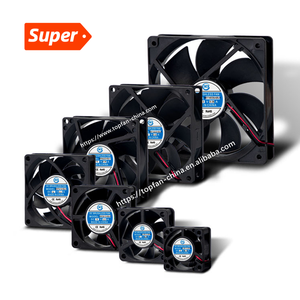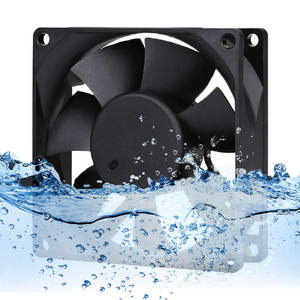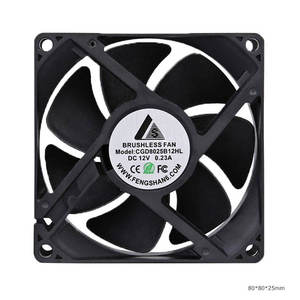(1807 products available)































































































































































































 Ready to Ship
Ready to Ship

















A 12-volt axial fan is a type of electric fan. Electric fans are classified into two main categories: axial fans and centrifugal fans. This is also the primary distinction for 12-volt axial fans.
12-volt axial fans can be further distinguished based on their shape.
It is necessary to clean the 12-volt axial fans regularly. First, turn off the power supply to ensure safety. Use a soft cloth or cotton swab to gently wipe the fan blades and housing. Avoid using the wet cloth to prevent water from entering the interior and causing a short circuit. If the fan is too dirty, users can use a hairdryer or an air compressor to blow away the dust. Then, use a mouth brush to softly brush the tiny parts. After that, use the wet cloth to wipe the externals. Ensure that the cloth is completely dry before plugging it back in. This method can effectively prevent dust buildup and ensure the fan operates smoothly.
Applications of the 12 volt axial cooling fan are wide-ranging. It is commonly used in the following areas:
HVAC Systems
A 12V axial fan is a key component of many HVAC systems. It's used for heat exchangers, condensers, evaporators, radiators, and other venting applications.
Cascade Refrigerators
Cascade refrigerators, which are often used in commercial cooling systems, rely on 12V axial fans for the efficient dissipation of heat from the compressor and condenser. By ensuring that these components remain within optimal temperature ranges, the fans help to maintain the overall performance and longevity of the refrigeration unit.
Computer Case Fans
A computer 12V axial fan is installed mostly in the power supply unit (PSU), graphics cards, CPU, and motherboard. It cools down these parts to keep the computer running smoothly.
Car Ventilation
A vehicle uses a 12V axial fan for the cooling system, electronic devices, power batteries, and ventilation pipes. The fan ensures the proper functioning of these systems, contributing to the overall performance, safety, and comfort within the vehicle environment.
Agricultural Facilities
In agricultural settings, such as greenhouses or livestock facilities, 12V axial fans can be used to create airflow and maintain suitable climatic conditions. They assist in preventing heat buildup, controlling humidity, and ensuring proper ventilation for plants or animals.
Medical Equipment
Some medical devices, like portable blood analyzers, may use 12V axial fans for cooling or ventilation purposes. These fans help maintain the functionality and comfort of the medical equipment.
Optical Transceiver Modules
3G, 4G, 5G, and GPON optical transceiver modules employ 12V axial fans for cooling. The fans ensure that the transceivers operate within safe temperature limits, preventing overheating and maintaining reliable data transmission.
Machinery
Axial fans can be found in various types of machinery, such as excavators, loaders, and mining equipment. They are utilized for cooling motors, inverters, and other components to prevent overheating and ensure the proper functioning of the machinery.
Selecting the right 12 volt axial fan for a particular application requires careful consideration of various factors to ensure optimal performance and compatibility.
Understand the application requirements
This is to look at the factors like the purpose of using the fan (cooling or venting), space availability, operating environment, noise tolerance, and budget constraints.
Determine the required airflow and pressure
It is important to select 12 volt axial fans that can deliver the needed airflow by looking at the CFM or liters per minute (LPM) ratings. Also, ensure that the fan can overcome any static pressure losses in the system by checking the static pressure requirement.
Evaluate the size and mounting options
Consider the available space and form factor of the fan or vent. Choose a fan with an appropriate diameter and thickness that fits within the designated space. Also, select the mounting method that aligns with the design requirements.
Consider the noise level
In applications with noise constraints, opt for 12V axial fans designed for low noise operation or consider selecting fans with higher speeds that may produce more noise.
Q1: What is the difference between a 12-volt fan and a 220V fan?
A1: Axial fans come in various voltage ratings. A12 voltage fan is compatible with low voltage systems, commonly found in automobiles. It draws power directly from the battery or DC power. On the other hand, a 220V fan operates in high voltage. It is designed to work with AC power from wall outlets.
Q2: Is a 12-volt fan better than a 5V fan?
A2: Both 12V and 5V fans serve their intended purpose. The 5V axial fan is more common in circuit boards and portable electronic devices. 12V fans are more powerful and versatile, applicable in cars,Boxes, and besides electronic components.
Q3: How long can a 12V DC fan run on a battery?
A3: With a rated capacity of 60 Ampere Hours, a 12 DC can run for 2.4 hours. The calculation is 60Ah/25=2.4 hours. The38 12 volt fan pulls 25 Amps of current. Actual hours may vary depending on the accessory.
Q4: What is the noise level of a 12 volt axial fan?
A4: The noise level of a 12V axial is different depending on the speed. The sound level increases with the increase in speed. However, many manufacturers design the fan to produce minimal noise. Usually, the noise level is between 45 and 85 decibels.